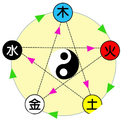The common cold is one of the most prevalent and ordinary illnesses. Many people believe that colds are only classified as wind-cold or wind-heat, but the classification is much more nuanced, and the differentiation is very detailed. Only with such precise differentiation can appropriate treatment be administered, leading to effective results.
In this article, we will discuss the exterior excess and deficiency patterns of wind-cold and wind-heat colds.
I. Exterior Deficiency and Exterior Excess Patterns
Generally, the distinction between exterior deficiency and exterior excess is primarily based on the presence or absence of sweating. Clinically, exterior deficiency patterns often present with sweating, along with symptoms such as aversion to wind, fever, and a floating and relaxed pulse. Regarding exterior deficiency patterns, the Shang Han Lun states: “In Taiyang disease, if there is fever, sweating, and aversion to wind, with a relaxed pulse, it is called a wind attack.” This indicates that the cause of exterior deficiency patterns is primarily due to the invasion of wind evil, which is a Yang pathogen that disperses and causes sweating. Analyzing from the perspective of the Eight Principles, exterior deficiency patterns occur when wind evil harms the body, and although there is evil qi at the surface, the body’s righteous qi is not deficient, thus it still falls within the realm of excess patterns. Additionally, if the patient has lung and spleen qi deficiency, the exterior is not tightly sealed, and the resistance is low, it can easily lead to the invasion of the six excess evils. When attacked by wind evil, presenting with sweating and other exterior symptoms, it also belongs to the category of exterior deficiency patterns. Clinically, exterior excess patterns are characterized by the absence of sweating, often accompanied by aversion to cold, fever, body aches, and a floating and tight pulse. Therefore, according to the Eight Principles, exterior excess patterns fall within the realm of excess patterns. In summary, exterior deficiency and exterior excess patterns are merely two major types of exterior patterns, which are relative to each other. To distinguish between exterior deficiency and exterior excess, one must consider the patient’s constitution, using the presence or absence of sweating as the basis.
II. Wind-Cold Exterior Excess and Wind-Cold Exterior Deficiency Patterns
Wind-cold exterior excess and wind-cold exterior deficiency patterns are both external patterns caused by the invasion of wind-cold, leading to disharmony between the nutritive and defensive qi, and can present with symptoms such as fever, aversion to wind and cold, stiffness in the head and neck, clear nasal discharge, a thin white tongue coating, and a floating pulse.
However, due to differences in constitution and resistance, the clinical manifestations vary. In wind-cold exterior excess, the wind-cold binds the exterior, blocking the pores, resulting in aversion to cold without sweating and a floating and tight pulse. Representative formula: Ma Huang Tang (Ephedra Decoction); for milder cases, Jing Fang Bai Du San (Schizonepeta and Fangfeng Powder) is used.
In wind-cold exterior deficiency, the pores are loose, and the nutritive and defensive qi are disharmonious, leading to aversion to wind with sweating and a floating and relaxed pulse. Representative formula: Gui Zhi Tang (Cinnamon Twig Decoction).
III. Wind-Heat Exterior Excess and Wind-Heat Exterior Deficiency Patterns
Wind-heat exterior excess colds are caused by the invasion of wind-heat evil, leading to disharmony in lung qi.
Symptoms of wind-heat exterior excess include: fever, slight aversion to wind and cold, nasal congestion with yellow and turbid discharge, sore throat, dry mouth with a desire to drink, absence of sweating, headache, and possibly cough with yellow phlegm, thin white or slightly yellow tongue coating, and a floating and rapid pulse. Representative formula: Yin Qiao San (Honeysuckle and Forsythia Powder).
Symptoms of wind-heat exterior deficiency include: fever, slight aversion to wind and cold, sweating, headache, cough with irritability, dry throat and thirst, red tongue with red edges, thin yellow tongue coating, and a floating and rapid pulse. Representative formula: Mao Wei Tang (Reed Decoction) with modifications or Wei Rui Tang (Polygonatum Decoction) with modifications.
Long press the QR code to follow!


